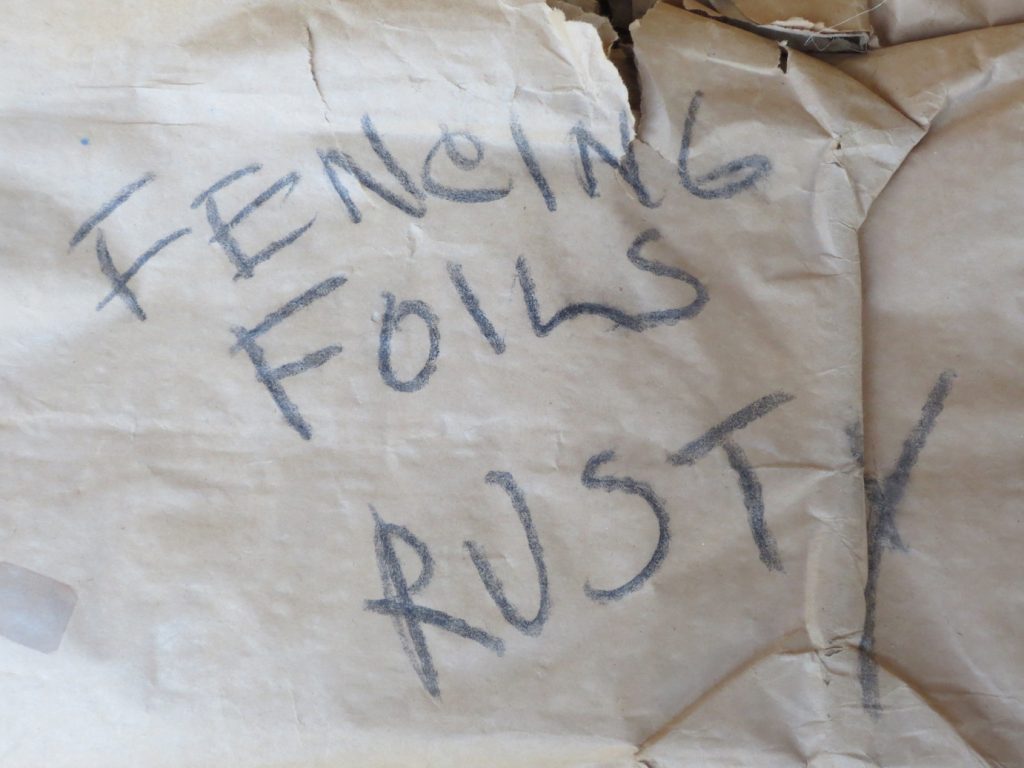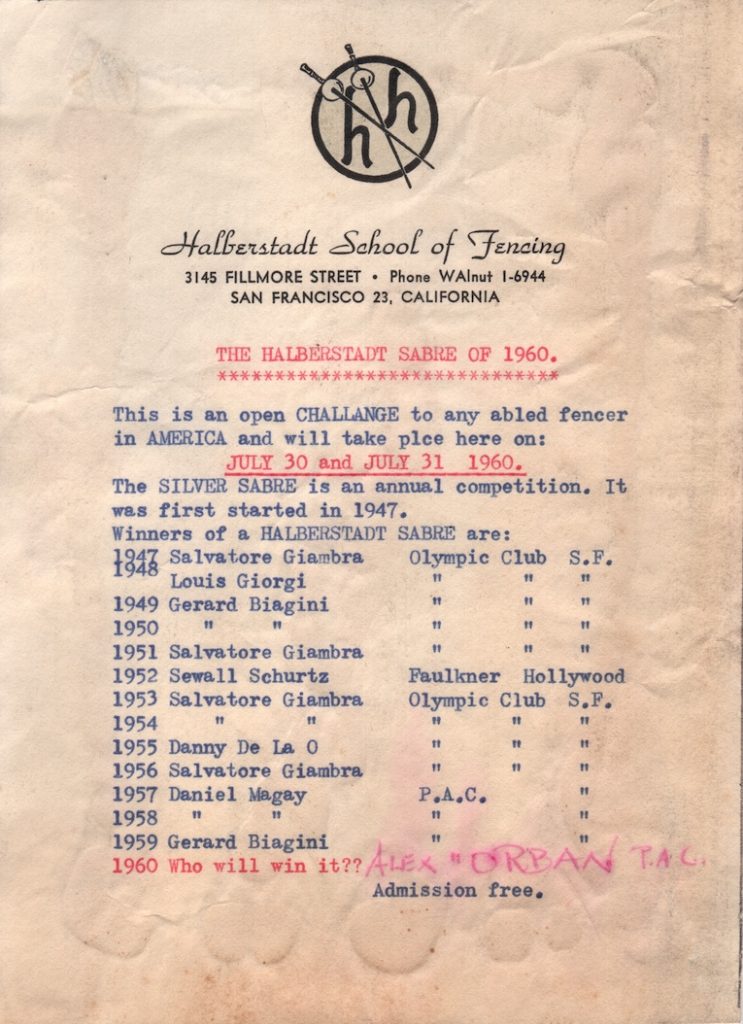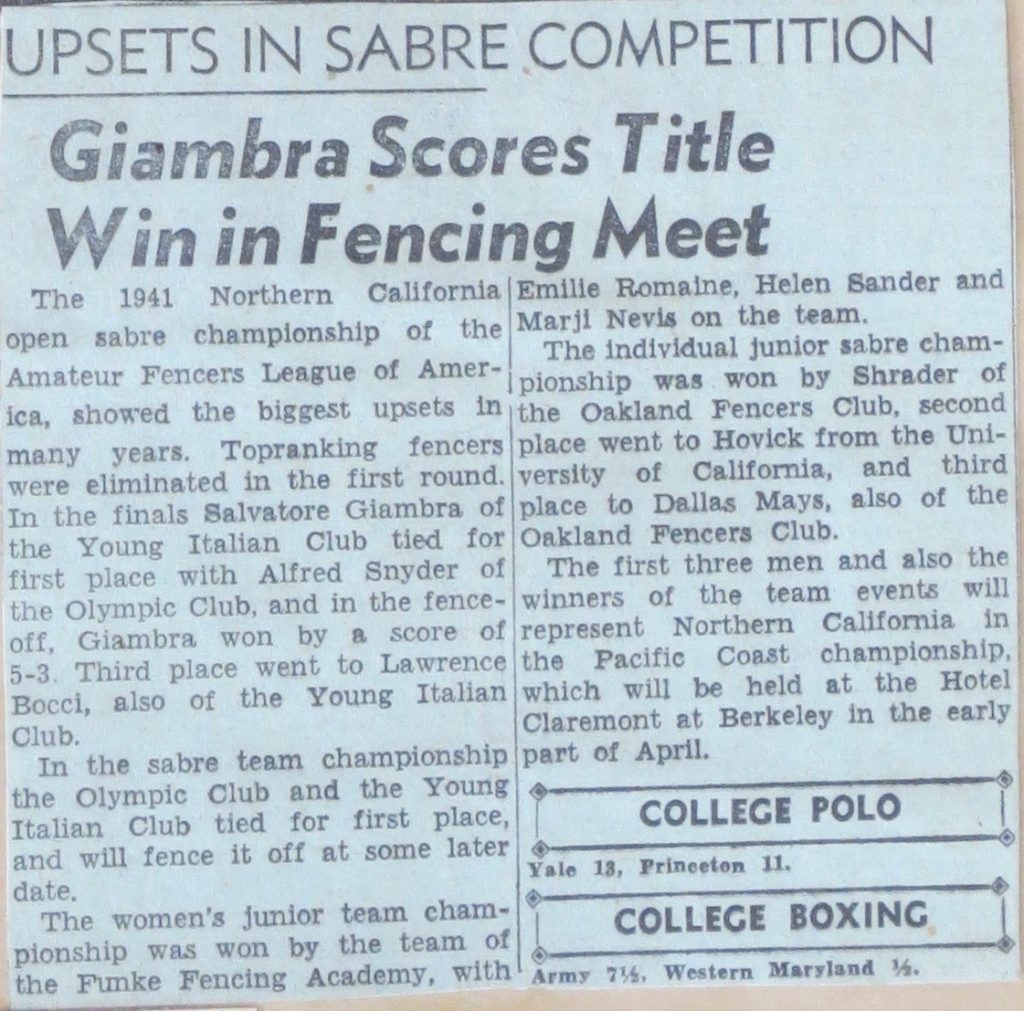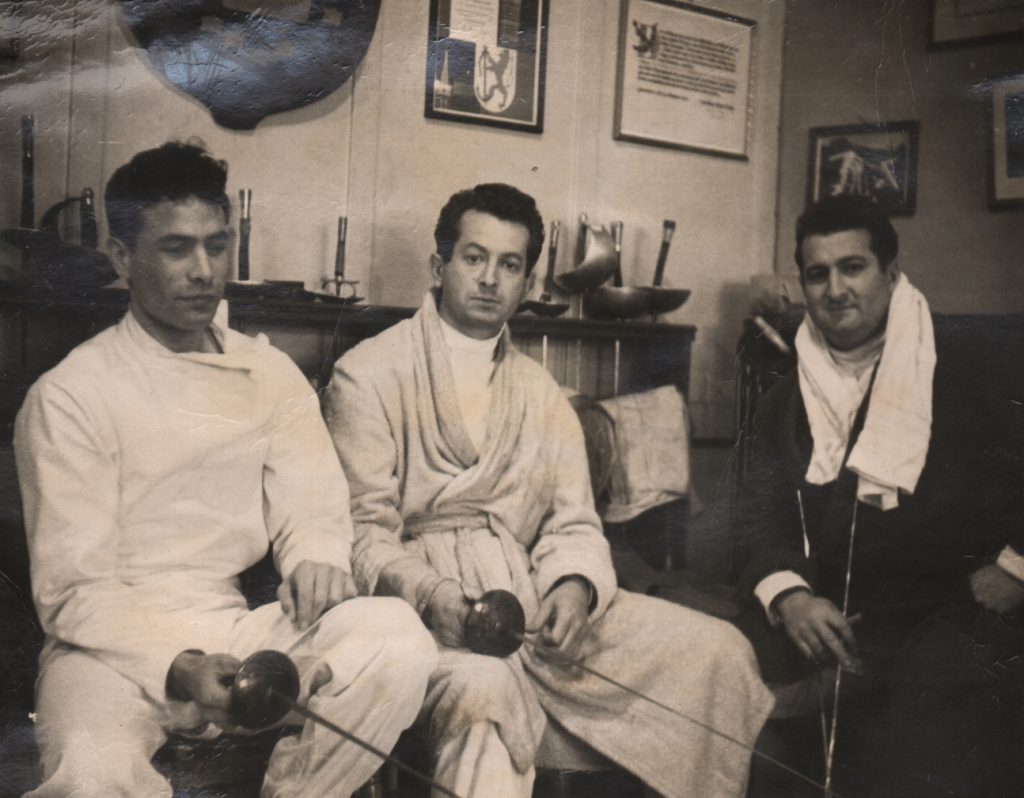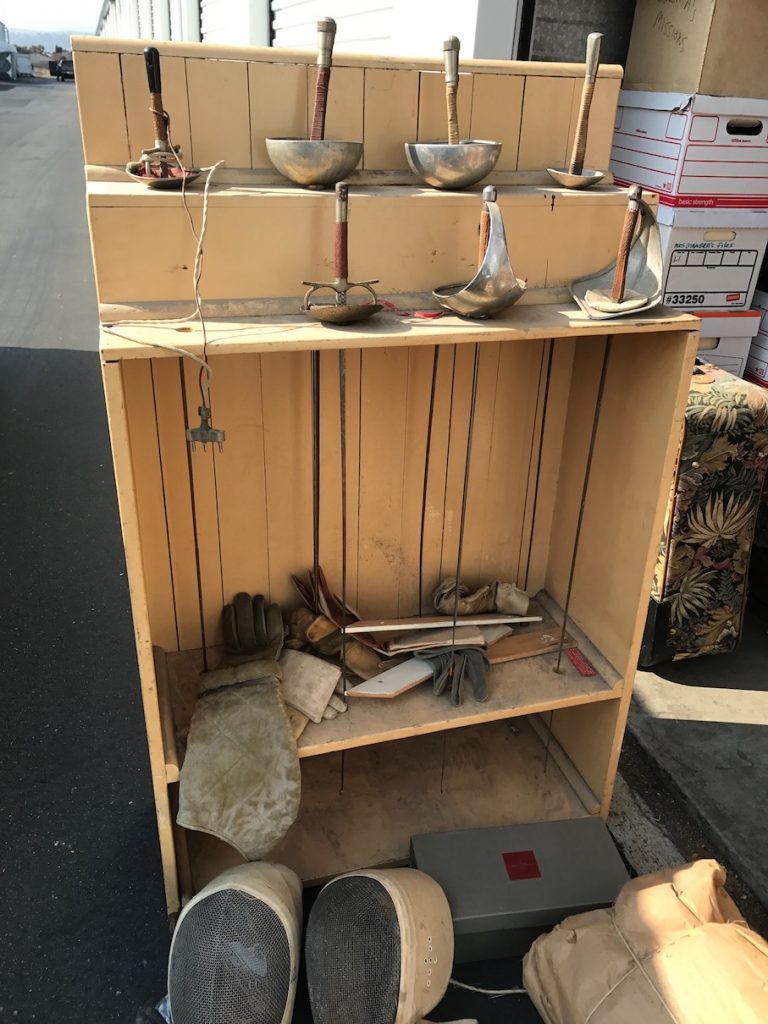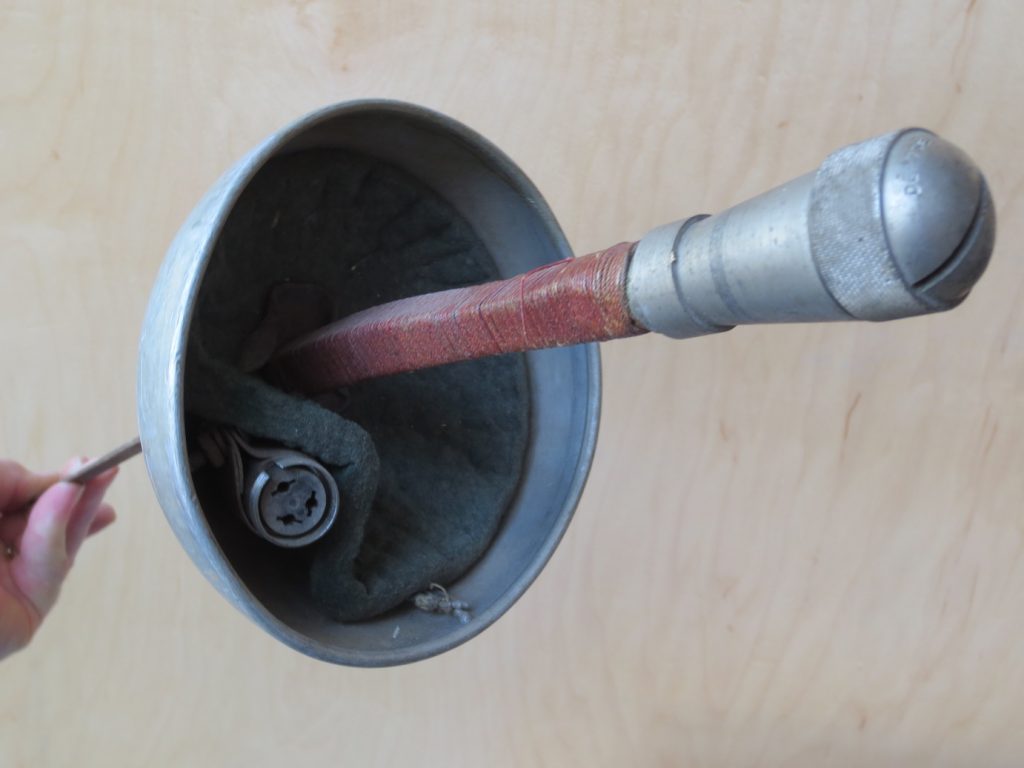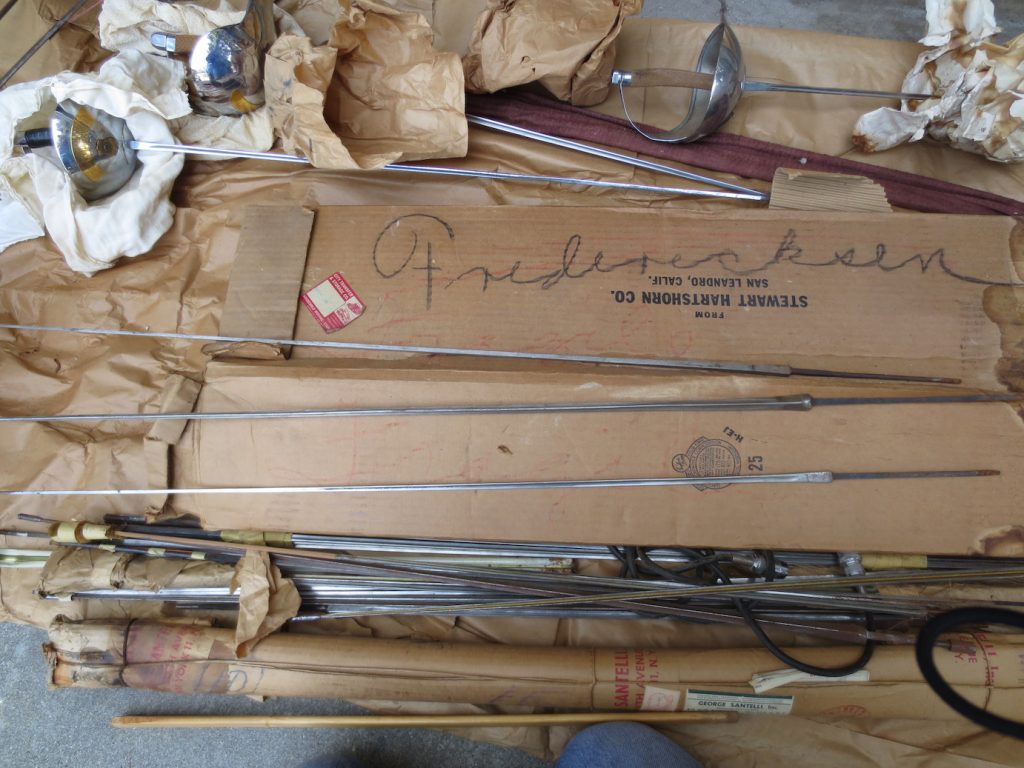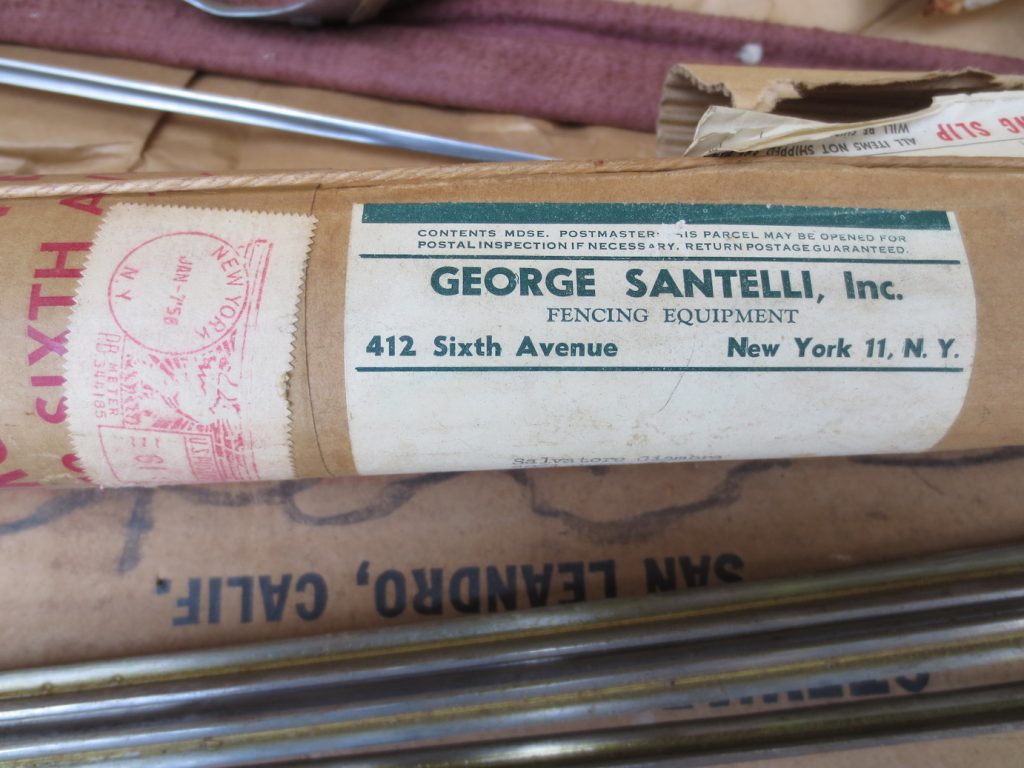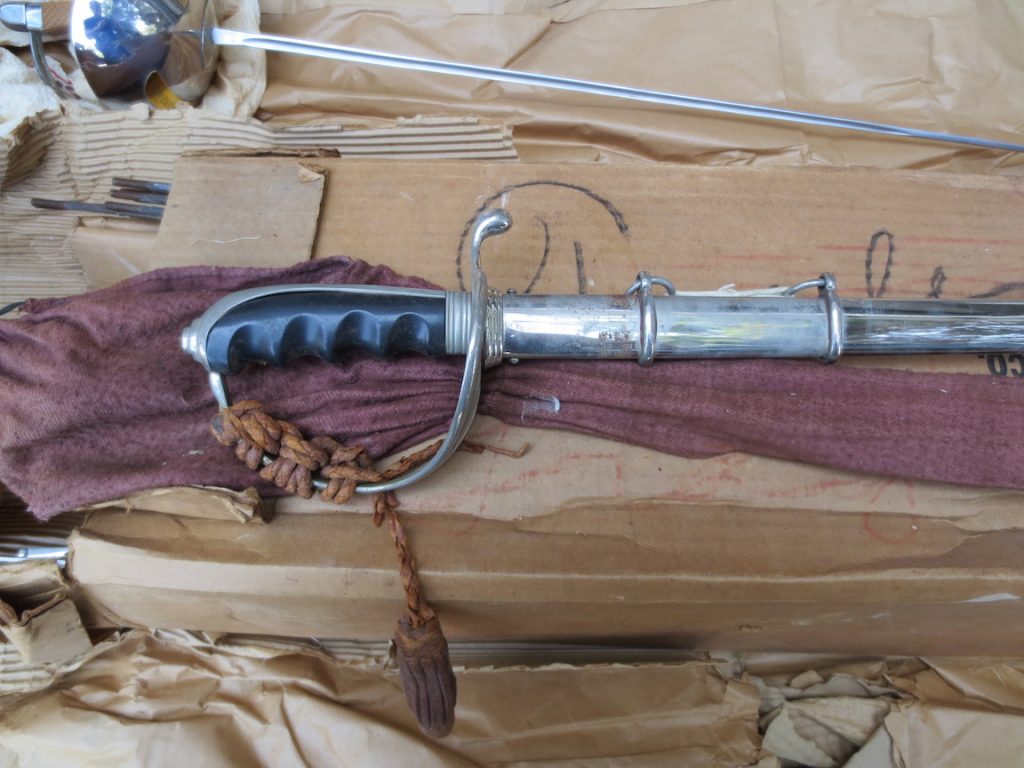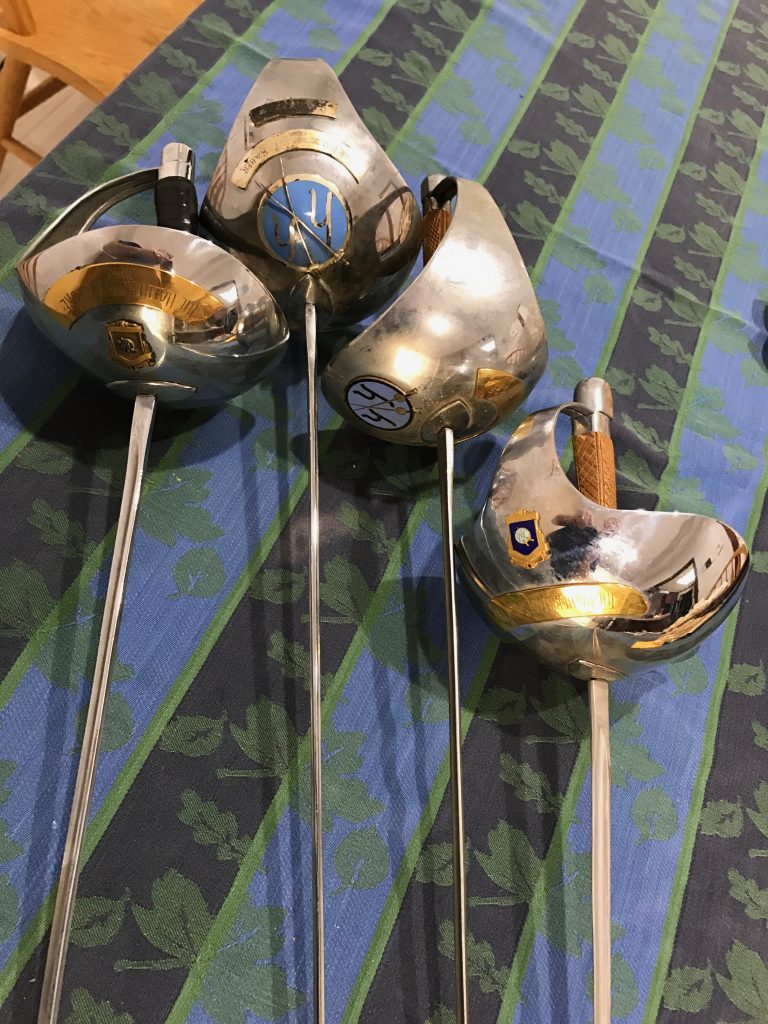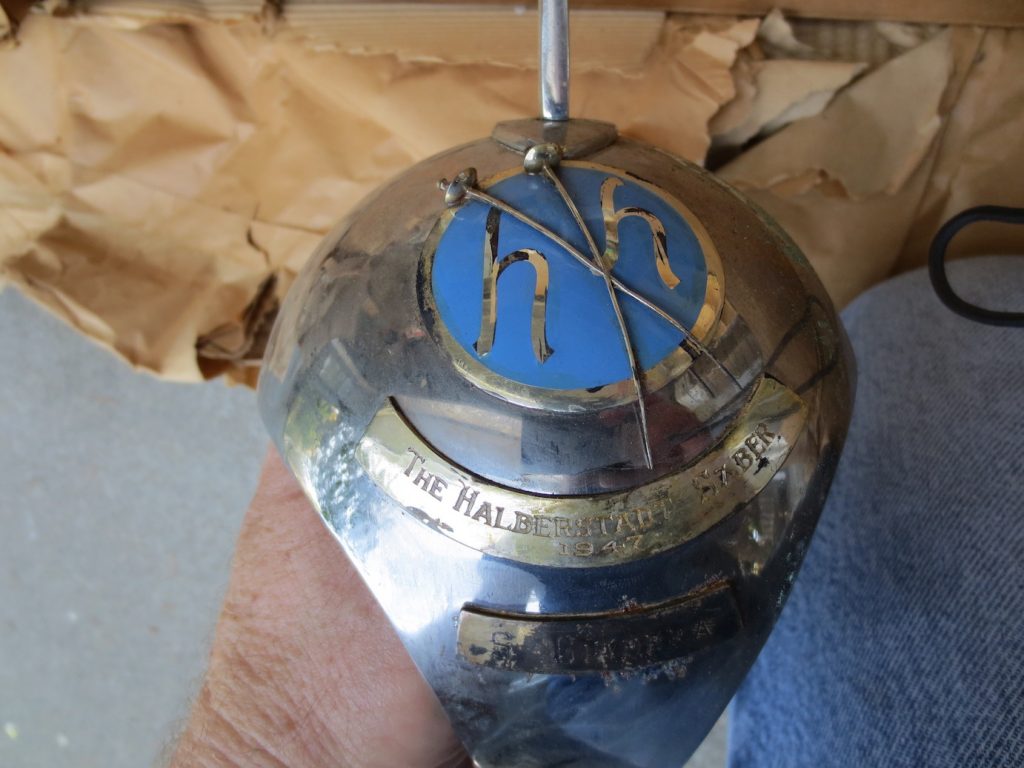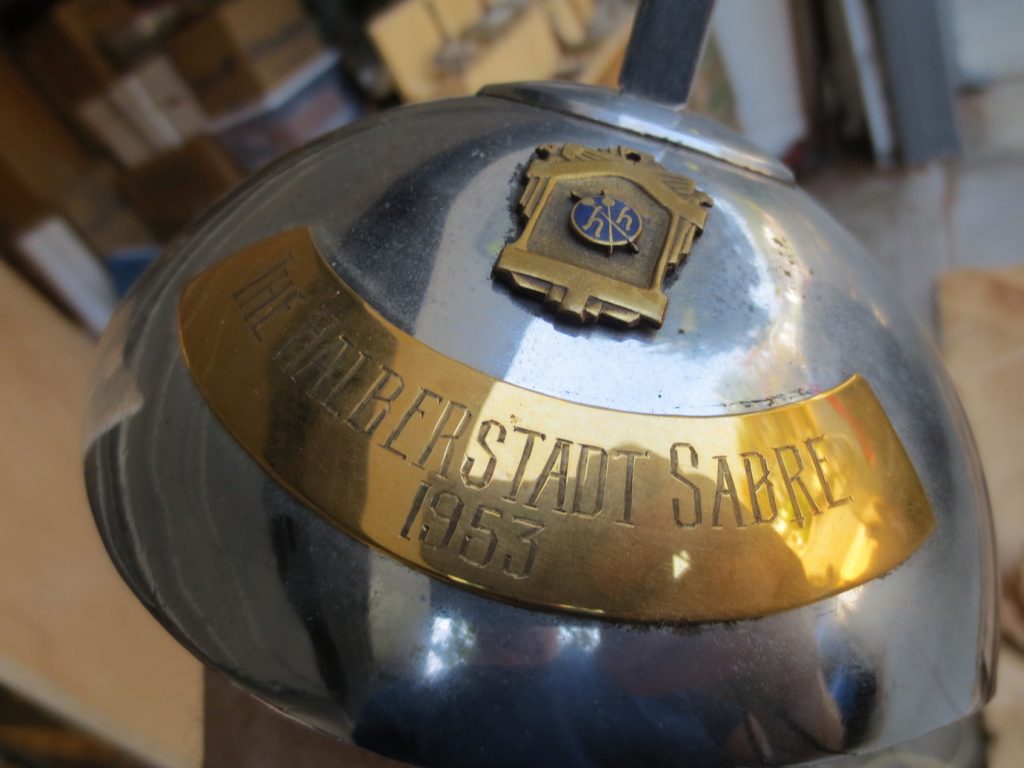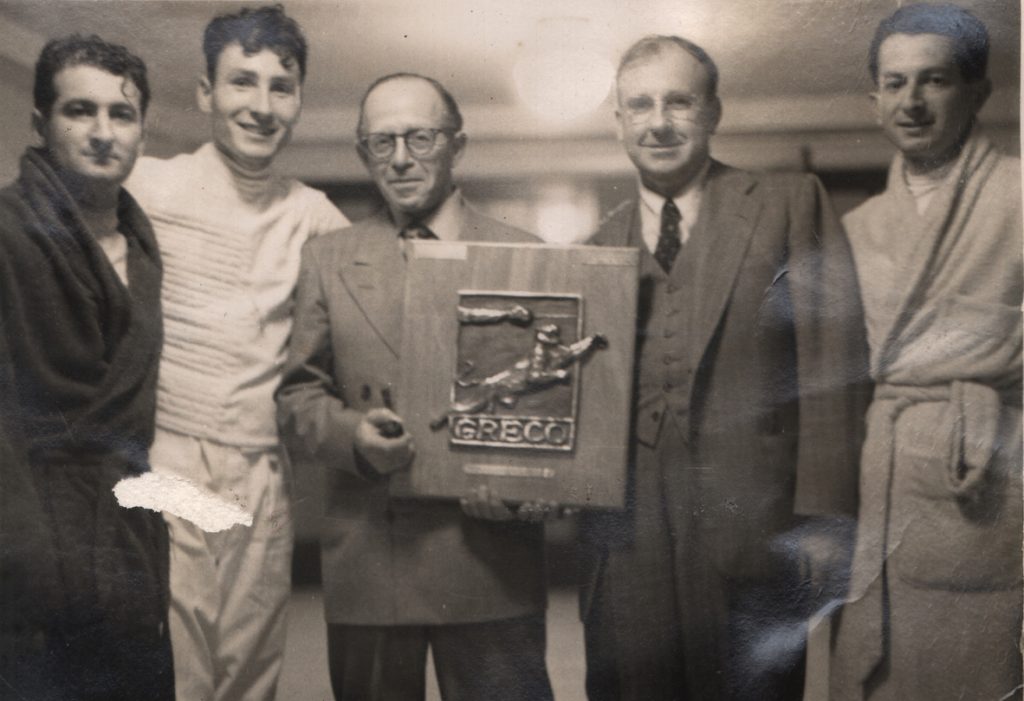A little over a year ago, I had a wonderful introduction to San Francisco’s Olympic Club and the club’s historian, facilitated by a couple of OC members, Chuck Lucasey and David Wessel. They are trying to re-emphasize fencing at the OC and asked me to lunch to help them get some of the club’s fencing background together for an article. (I hope I helped them.) The Olympic Club has a long history in the sport and once gave a great deal of support to competitors, while also providing a venue for competitions. Support began to wane around the time of Hans Halberstadt’s death in 1966 and hasn’t regained its former station. Yet. Here’s hoping Chuck & David are successful in their ongoing efforts.
After the lunch, I was introduced to the Archivist for the Olympic Club, Jessica Smith. She brought along some scrapbooks and memorabilia from her collection outlining some of the historical highpoints of fencing history at the OC. Great stuff. Also at the meeting, she mentioned that she was in communication with the daughter of a long-time OC fencer, one Salvatore “Sal” Giambra, who was planning to donate material from her family to the club.
Many moons go by.
A couple of months ago, I received an invite from Jessica to come to the OC to view the bequest of the Giambra family to the Olympic Club. Salvatore Giambra was an excellent fencer who got his start in the 1930s at Unione Sportiva Italiana. His first coach, as with so many other San Franciscans of Italian descent from that time period, was Maestro (and later Glovemaker to the Stars, or at least to the Knowledgeable Fencer) Eduardo Visconti. Visconti retired from coaching when the club was shuttered just prior to the outbreak of World War 2, so Sal, as he was known, transferred his membership to the Olympic Club and began lessons with Hans Halberstadt. Hans had opened the Halberstadt Club in 1941 and taught there and at the OC from 1942 until the early 1960s (I believe. Still trying to confirm the actual end date for Hans at the OC). Sal was many times the Pacific Coast Sabre Champion, won the Halberstadt Sabre competition five times, including the premiere edition in 1947, and served as the Team Captain for the US Fencing Team at the 1948 London Olympic Games.
The 1960 version of the annual invite for the Halberstadt Sabre, listing all previous winners. Bless you, Hans Halberstadt, for keeping this record. Sal Giambra took home first prize five times. And first prize was worth taking home. Wait & see.
Sal also served as the on-film partner to Helene Mayer in a movie made at UC Berkeley which, if you have 11 minutes, may be seen here:
https://collections.ushmm.org/search/catalog/irn561067
Sal shows up in the Halberstadt Scrapbooks frequently, both in photos and news articles about this or that local event. He usually would wind up on the podium, irrespective of what weapon happened to be to the fore on any given day.
The earliest mention I can find of Sal Giambra winning a fencing tournament. This clipping is from 1941. Interestingly, his opponent in the fence-off is Alfred Snyder, who is on my list for historic exploration. Snyder was a Stanford fencer, won the US National Foil title in 1944 and is the only one-armed US National Fencing Champion. His story is for another day.
A 1952 photo of Sal Giambra, far right. Also pictured are Daniel De La O, left, and Sal’s brother Frank Giambra. This photo shows them all ready to fence at the Halberstadt salle.
Fast forward once again. I was contacted by Salvatore Giambra’s daughter, to whom I had been introduced by Jessica at the OC. The OC had taken all of Sal’s fencing memorabilia that they had space for, but there was some more material in a storage unit that needed a home. And was I interested in it. My answer, as you may imagine if you’ve been following this space for longer than a minute, was a resounding “Yes!” Sight unseen – my favorite kind of collection!
Jessica, Gina Giambra and I met at the Giambra storage unit. Meeting Gina was such a treat. I think she was very happy to know that I was aware of her father’s history as a fencer, and to know that the rest of his fencing memorabilia was going to a place, as with the OC, where it would be appreciated.
The Rack. Sal likely made this sword rack himself. Room for 8 weapons!
As Gina opened up the storage unit, right in front sat a rack full of swords so I knew we were in the right place. Two sabres, two electric epees, two Italian foils – one electric, one standard – and a standard French foil. Something for everyone! Plus gloves, an epee sleeve, two masks and a metal box for small bits & pieces. The electric epees were intriguing. Sal was an electrical engineer and had spent some time working on a new wiring system for fencing epee with a scoring machine. I believe – someone correct me if I’m wrong on this – that his guard socket and wiring were his own design. Take a look.
The Giambra guard socket? Anybody ever seen anything like this?
The socket looks like a fairly standard (for the time) electrical plug. Three prongs, as it should be, and the bodycord plug screws into the threads on the socket ring. It’s certainly not going to fall out and is less cumbersome than what we’re still using today. At least, it seems to be a slightly smaller footprint. I haven’t plugged one in to a machine yet to see if it will still work. I am curious, though. I’ll try to remember to give that a shot and see if I don’t electrocute myself. But there was another fun feature:
That’s right! Pineapple tip! On an epee, no less. I’ve seen them for foils, but didn’t know they were also the standard for epee. How long did that last?
Who would want to get hit by that? Ok, the truth is, it’s better than the earlier alternative. Prior to this tip and electric scoring, back in the day (before 1936, although non-electric tournaments for epee continued long after) there was the point d’arret, which could be described as a three-pronged life shortener. The interim electric point, the one just after the point d’arret and prior to the above, had four shorter prongs extruding from the end of the plunger tip. It could hook onto a jacket almost as well as the point d’arret. I have some examples of this that I’m tempted to wire onto a new epee blade and try out – with an old jacket. It looks capable of doing a fair bit of damage. Comparatively, the pineapple tip above seems almost harmless.
In addition to the sword rack, there was a fencing bag with a few weapons, a plaque reading “S. P. Giambra” and a large bundle wrapped in cardboard and butcher paper, tied together with that old type of twine that probably isn’t made anymore. It was neatly done. I half expected to find a long, thin Maltese falcon inside. And while what was inside is maybe not as valuable in terms of encrusted gems, what I discovered was still pretty spectacular from where I’m sitting.
The initial un-wrap.
I don’t know who the “Fredricksen” might be whose name was written on the box I found inside the package. Another mystery unsolved. But there was some pretty fascinating stuff to see. A fair number of blades. Mostly sabre and epee. One unopened package of blades from a famous New York based weapons dealer, as seen here:
Blades from Santelli, still in their original package. I haven’t opened it. I’m not sure I ever will.
The date on the postmark is Jan. 7. 1958. Before I was born (though not by much) but near the end of Salvatore Giambra’s competitive years. I can only assume he ordered the blades thinking he might need them, then found that he was no longer fencing enough to warrant unwrapping the package. So I don’t know if they’re foil, epee or sabre blade. Wired? Unwired? Ah, a mystery. I think I’ll leave it as it is.
In addition to the bundle of Santelli blades, there were a number of loose blades, some epee bodycords all of the Giambra design, and a decorative, engraved sabre. And a saw. You know, like, a saw. For cutting wood. Why? Who knows?
The sabre, not the saw. I’m not including a picture of the saw. I mean, it’s a saw.
Now, I’ve been teasing the big reveal in a couple of the pictures above. Did you notice? The shiny silver sabres? Not to mention the reference to the 5 Halberstadt Sabre victories?
Ok, a little backstory. Hans Halberstadt, he that was the founder of the still going strong Halberstadt Fencers Club of San Francisco, in addition to teaching the sport, also sold fencing equipment out of the basement of his salle/home. Beginning in 1947, he hosted an annual sabre competition, the Halberstadt Sabre Tournament. First prize was a chrome-plated sabre that he would dress up with engraved plates and other cool touches. Each year was different than the last. I’ve seen quite a number of them. The Halberstadt club has 1952, won by Sewall “Skip” Shurtz. Dan Magay still has the three that he won in 1957, 1958 and 1964. Charlie Selberg had one that is now in The Archive collection, although I have no idea how he came by it. The Olympic Club has one, given to them by Gina Giambra. So of the five that Sal won, the Olympic Club has one – and The Archive now has the other four. They were all in the wrapped package of ‘rusty foil blades’ that were stashed in the Giambra storage unit.
Not a great photographic composition, but you can at least get a good look at the four sabres.
Like I said, they’re all different, and they’re all super cool. But I don’t think any are quite as cool as the very first one from 1947:
The 1947 Halberstadt Sabre trophy.
I believe it’s the only one with the winner’s name engraved on it, but there are still a few I haven’t seen. The crossed blades on the Halberstadt logo are raised off the face of the plaque. Here’s a better view:
Is that super cool, or what?
The guard is chrome plated as mentioned above, so still super shiny. Now, did Hans do all this work himself, or did he send some of it out? I’d assume he didn’t do the engraving, but there’s some pretty custom work here. The engraved plaques have to not only bend around the guard, but also conform to the shape of the guard’s curve. And I assume they’re riveted into the guard, but I haven’t looked at the inside to see. Silly me. I should look. Here’s another:
The 1953 Halberstadt Sabre trophy. I mean, really. Were medals like the one at the top of the guard easier to make back then? Why can’t we have nice things anymore?
Hans passed away in 1966 and the tournament was last held in that year. I know the names of almost all of the winners, but there is one that I’m uncertain of. Helmuth Resch, a member of the Austrian Olympic team, won in 1961. Gerard Biagini in 1962, making him a 4-time winner. Dan Magay won again in 1964, bringing his total to 3 victories. Jack Baker, 1965. Someone named Bouchee from Detroit won the last in 1966, so 1963 is the only one I have no record of. What I don’t know is whether Hans was able to continue the tradition of awarding one of these stellar sabres as a trophy right up to the end. It seems pretty likely; Dan has one for all three of his victories, so they were around at least until 1964. Regardless, I feel pretty good that, of the twenty years the tournament was fenced, I’ve held 10 of the sabres and 5 reside in The Archive collection.
I owe a huge debt of gratitude to Gina Giambra and to Jessica Smith of the Olympic Club. I haven’t yet put Sal’s sabres out in my display cases at the West Berkeley Fencing Club, where I’m based. But I hope to, and soon.
Let’s wrap up with a final picture of Salvatore Giambra and some friends. This one is from 1951.
L-R: Salvatore Giambra, Gerard Biagini, Hans Halberstadt holding the Greco trophy, unknown and Frank Giambra.
And all of this comes about thanks to the lunch I was fortunate to share with Chuck Lucasey and David Wessel, current Olympic Club members. I owe you guys. Hey, invite me back! I’ll buy!


